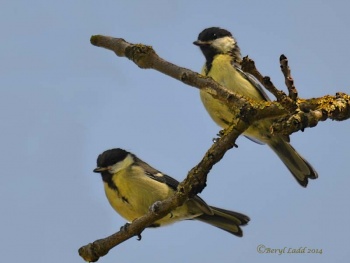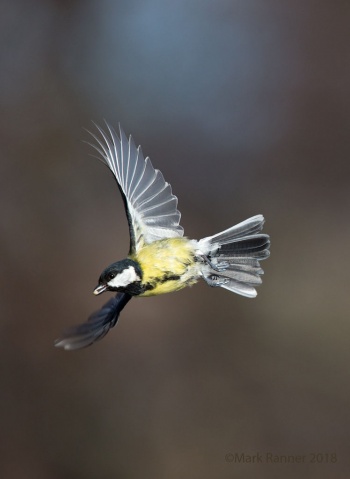| Line 43: | Line 43: | ||
A woodland bird but nowadays a garden bird. Sometimes aggressive, fighting with other tits. In winter forms mixed feeding flocks with [[Blue Tit]], [[Coal Tit]]. [[Eurasian Treecreeper]] and other species | A woodland bird but nowadays a garden bird. Sometimes aggressive, fighting with other tits. In winter forms mixed feeding flocks with [[Blue Tit]], [[Coal Tit]]. [[Eurasian Treecreeper]] and other species | ||
| − | Frequent visitor to birdtables and seed-dispensers, thus well known. Bold, at times plain audacious, may take seed from outstretched hand. | + | Frequent visitor to birdtables and seed-dispensers, thus well known. Bold, at times plain audacious, may take seed from outstretched hand. It tends to forage on the ground more often than other tit species. |
====Diet==== | ====Diet==== | ||
Insects and seeds, suet, beech nuts etc. | Insects and seeds, suet, beech nuts etc. | ||
Latest revision as of 03:16, 6 April 2023
- Parus major
Includes: Turkestan Tit
Identification
12·5–14 cm (5-5½ in); the largest European tit
- Yellow and green
- Glossy black head
- White cheeks
- Vertical black stripe on chest (broader on male)

Photo © by Askar Isabekov
Kazakhstan Shelek (Chilik), Enbekshikazakh region, Alma Ata oblast, Kazakhstan, March 2007
Juvenile: cheeks are yellowish
Similar Species
The occasional bird is much greyer than the typical one, and needs to be compared carefully to Coal Tit which has two wing bars, different shape to the white spot on rear head/nape, and looks larger headed.
Distribution
From Europe and north Africa through central Asia to western China.
In Wisconsin, USA, this species has been observed regularly (including breeding) for nearly twenty years, but at this time the species is not considered established by any North American birding authorities.
Taxonomy
Cinereous Tit and Japanese Tit were formerly included in this species. Turkestan Tit (bokharensis, ferghanensis and turkestanicus) was formerly considered a full species.
Subspecies
This is a polytypic species [1] consisting of 15 subspecies:
- P. m. newtoni: in the British Isles
- P. m. major: Europe to north-western Iran, Siberia, Lake Baikal, Altai and Sayan mountains
- P. m. kapustini: North-western China (north-western Xinjiang) to Mongolia and eastern Siberia
- P. m. corsus: Iberian Peninsula and Corsica
- P. m. mallorcae: Balearic Islands
- P. m. ecki: Sardinia
- P. m. excelsus: North-western Africa (Morocco to Tunisia)
- P. m. aphrodite: Southern Italy, Sicily, southern Greece, Mediterranean islands and Cyprus
- P. m. niethammeri: Crete
- P. m. terraesanctae: North-western Syria, Lebanon, Israel and Jordan
- P. m. blanfordi (karelini): Northern Iraq and Iran
- P. m. intermedius: North-eastern Iran and adjacent south-western Turkmenistan
- P. m. bokharensis: Russia to Tien Shan and Karatau mts. and north-western Afghanistan
- P. m. ferghanensis: Southern Kirgiz and western Tien Shan mts. to western Pamirs and Turkestan
- P. m. turkestanicus: Lake Balkhash to western China (Xinjiang) and south-western Mongolia
Habitat
Parks, woodlands and gardens all over Europe
Behaviour
A woodland bird but nowadays a garden bird. Sometimes aggressive, fighting with other tits. In winter forms mixed feeding flocks with Blue Tit, Coal Tit. Eurasian Treecreeper and other species
Frequent visitor to birdtables and seed-dispensers, thus well known. Bold, at times plain audacious, may take seed from outstretched hand. It tends to forage on the ground more often than other tit species.
Diet
Insects and seeds, suet, beech nuts etc.
Breeding
Breeds in all kinds of woodland (incl. in desolate taiga in far north) and in immediate proximity of man in parks and gardens.
Nests in roomy nestbox, tree-hole (e.g. decayed fruit tree), air duct and even letterbox. The clutch consists of 5-12 white eggs spotted reddish-brown which are incubated for around 2 weeks. The young fledge at around 16-22 days.
There may be a second brood if there is plenty of food. The breeding season runs between April to August in the UK.
Vocalisation
References
- Clements, J. F., T. S. Schulenberg, M. J. Iliff, D. Roberson, T. A. Fredericks, B. L. Sullivan, and C. L. Wood. 2018. The eBird/Clements checklist of birds of the world: v2018. Downloaded from http://www.birds.cornell.edu/clementschecklist/download/
- Avibase
- Bird Watching
- Handbook of the Birds of the World Alive (retrieved August 2014)
Recommended Citation
- BirdForum Opus contributors. (2024) Great Tit. In: BirdForum, the forum for wild birds and birding. Retrieved 27 April 2024 from https://www.birdforum.net/opus/Great_Tit
External Links
GSearch checked for 2020 platform.1






